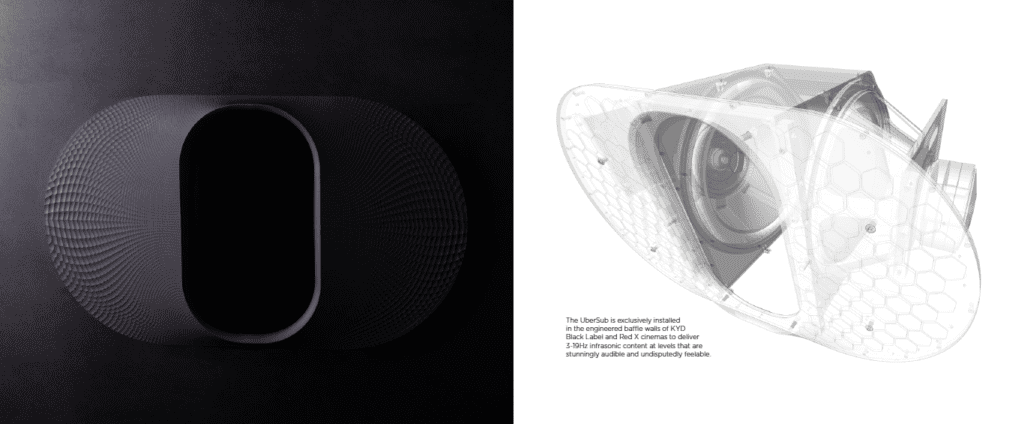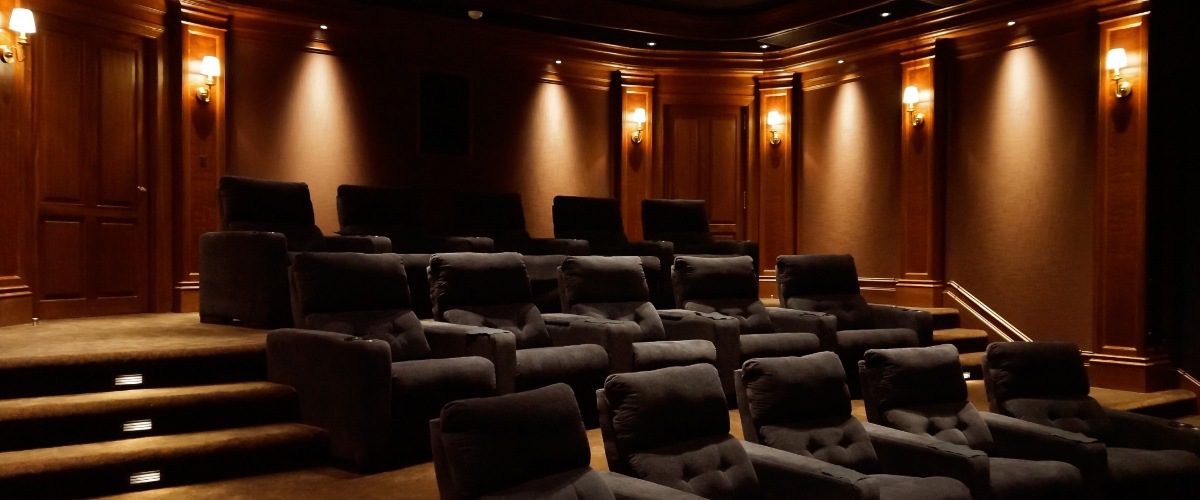Keith Yates Design (KYD) was awarded the Home Theater of the Decade by the AVS Forum back in 2019 for their project with cinematographer Rob Hahn, and it’s easy to see why after browsing the photos and learning the lengths both Yates and Hahn went to in order to create the home theater, including the creation of an entirely new subwoofer.
Rob Hahn’s motivation to build such an ambitious theater came directly from his experience as a DP (Director of Photography) in Hollywood, where “you work for months and months away from your family, only to see your work displayed in movie theaters on screens with dim bulbs, incorrect framing, out of focus lenses, and sound so painfully loud, it’s unpleasant,” says Hahn.
To solve this problem, Hahn decided to “build a theater that will properly showcase films in the manner they were meant to be seen – on a large constant-area screen, with powerful, intense yet delicate sound.”
“Rob Hahn first connected with me in early 2012 for what would turn out to be our tenth Black Label project, but this time with two pivotal differences,” Yates recounts. “First, Rob’s infectious passion sparked the architectural direction and animated our engineering discussions. And second, he ended up publicly sharing, in three AVS Forum threads, what we were up to and some of the art and science behind it,” says Yates.
Yates’ vision was inspired after sitting under the stars at the edge of the Grand Canyon. Legs dangling over the abyss and staring into the blackness, he imagined a giant, brilliant film screen appearing maybe 50 yards in front of him, somehow magically suspended over the canyon, the glowing image surrounded by the huge black chasm. The screen was a vivid window into another world, like a giant light bulb, but with no light-reflecting surfaces around it to dilute the intensity and purity of the filmmaker’s vision.
Together, they collaborated on Yates’ architectural sketches and his team’s 3D computer model, which allowed Hahn to navigate around, zoom in and out, and attach notes to elements as large as the stage and proscenium, and as small as the tiniest molding profile. The result that their back-and-forth produced was something even better than Yates’ Chasm. They got Hahn’s Chasm, and many agree that it worked.
Inventing a Solution to Let Audience Suspend Disbelief
Human hearing extends down to 2.5Hz, which is three octaves below 20Hz, the low frequency “limit” tossed around in the AV world. This ultra-deep bass region below 20Hz is referred to as infrasonic. There’s not much natural infrasonic content in music, though movies are positively pulsing with it: collisions, explosions, slams, stampedes, trains, helicopters, thunder, earthquakes, even the relatively distant sound of the family car quietly burbling in the garage.
Although it’s easy to find infrasonic-rich movie content, it’s nearly impossible to find a subwoofer that can actually reproduce it.

The physics of infrasonics are punishing: think 2-foot diameter subwoofer drivers in cabinets the size of walk-in closets. And Hahn would need half a dozen of those closet-size behemoths plus a rack of multikilowatt amplifiers to drive them. When Hahn said the first test disc he intended to play in his new room was Spielberg’s War of the Worlds, Yates knew they had to actually solve the problem, and cleanly, from 20Hz all the way down to 3Hz.
The end result of tackling this monster of a challenge was KYD’s invention of their UberSub infrasonic subwoofer, six of which were installed into an engineered baffle wall taking up no additional space.
A blind college Psychoacoustics instructor of Yates’ had a knack for walking into an unfamiliar space and describing its size, shape, and placement of major furnishings. We all, blind or sighted, identify our surroundings by the way sound reflects off things in front of, behind, above, below, and to the sides of us. After Yates’ first meeting with Hahn, he imagined his blind instructor walking into Hahn’s theater, only to give up and say, “I have no idea how big this room is, or its shape, nothing. Yet I hear a room with a rich, natural ambience all around me; it’s alive and glows.”
If Yates could get Hahn’s room to create a rich, soft acoustic glow, free of any strong individual reflections, he could stop the room from breaking the spell by announcing, ‘Hey, wait, you’re not in a jungle, you’re just in a living room watching a movie.’ Without the room’s specific acoustic signature fighting the soundtrack’s, Hahn would be much more likely to suspend disbelief and enter the movie.
Yates’ pursuit led to the team to model different acoustic scheme solutions using ray-tracing, finite-element analysis, fluid dynamics simulations, and strange 3D microphones designed for concert hall and auditory perception research.
Creating the Quietest of Quiet Rooms
With the room envelope and projector enclosure optimized to reject intrusive noise, the heating/cooling system stood as the largest source of noise pollution.
The noise criterion for the room was set at NCB 0 with the HVAC system operating at 7-10 air changes per hour. This ventilation rate, driven by our Indoor Air Quality requirements, is 3 to 4 times higher than commonly achieved in custom homes in North America.

The measured result was a NCB -6 (minus 6), which is just below the human hearing threshold, and appreciably quieter than any known residence or professional cinema, dubbing stage, director screening room or recording studio in the world.
Hahn reported that, when first entering the theater, his friends and movie-industry colleagues remark that, in contrast to the closed, claustrophobic nature of anechoic test chambers and other ultra-quiet environments, his theater is the opposite, sounding large, spacious and airy.
“I can’t tell you how many times I’ve heard, ‘I could live in here, starting right now, Rob,'” says Hahn. “Every one of my guests starts rattling off dozens of movies they want to see now ‘for the first time’ (whether they’ve previously seen it or not). Dream realized.”
Technology Included in the Installation (by manufacturer):
- 3 SDA-8300 (8×300-watt) power amplifier
- 1 SDA-4600 (4×600-watt) power amplifier
- 3 M2 Main (left, center, right) speakers
- 4 AC28/26 Front side surround speakers
- 6 8340A Side and rear surround speakers
- 10 SCS-8 Top/ceiling surround speakers
- 8 SHOC-24 subwoofers with IWSv2 amplifiers
- 1 Strato Movie player
- 12 DV700 Disc vaults
- 2 Terra Movie servers
- 3 No.531H 300-watt mono power amplifier, drive woofers of JBL M2 speakers
- 1 No.533H 3×300-watt/ch power amplifier, drives high-frequency of M2 speakers
- 1 Directors Choice 4-way masking video screen, microperforated Sno-Matte material, 228” x 110” video image
- 1 4K SXRD Home Cinema Projector VPL-VW5000ES, 5,000 lumen brightness
- 1 Altitude 32-channel Preamp Processor, Dolby Atmos, DTS:X Auro-3D
- 6 Infrasonic UberSub Modules incorporating horizontally opposed, force canceling 24-inch drivers powered by 6,000 watts amplification each







